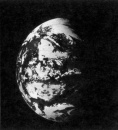Sep 15 1968
From The Space Library
Zond V automatic space station was launched by U.S.S.R. and placed on lunar trajectory from parking orbit of another satellite to explore outer space and test spacecraft systems, Tass announced. All systems were functioning normally. Speculation in Moscow, later confirmed, was that spacecraft would attempt to circle moon. On Sept. 18 Sir Bernard Lovell, Director of U.K.'s Jodrell Bank Experimental Station, said spacecraft had passed within 1,000 mi of moon and was returning to earth and predicted U.S.S.R. would attempt to recover it. West Germany's Bochum Observatory agreed that Zond V was returning but insisted spacecraft had circled moon. U.S.S.R. initially denied both reports, but two days later, confirmed that Zond V had circled moon Sept. 18 and was continuing its flight. Tass said spacecraft had flown within 1,200 mi of moon and obtained data on physical characteristics of outer space near moon. Research mission had been completed and spacecraft was continuing to relay information to space stations.
Zond V's reentry and splashdown in Indian Ocean Sept. 21 was recorded by U.S. U.K., and West German space scientists, but U.S.S.R. made no official announcement until Sept 22. Tass then said Zond V had circled moon, explored space near moon, reentered at 11,000 mi per sec, softlanded by parachute in predetermined area, and was recovered by Soviet recovery ship-becoming first circumlunar spacecraft recovered on earth.
"During the flight the station's systems and aggregates for maneuvering on the trajectory and for returning to the Earth were tested. Flight control systems of the station and the radio-engineering means for measuring the parameters of its trajectory ensured the successful execution of the programme. "The successful flight of the 'Zond-5' automatic station over the Earth-Moon-Earth route, and its return to the predetermined area are an outstanding achievement of Soviet science and engineering. Another scientific-engineering problem has been solved, and broad prospects have been opened up for further research of outer space and planets of the solar system by automatic space stations which bring back research data to the Earth."
Tass announcement that atmosphere and pressure "remained within the limits of their present range" supported earlier speculation that Zond V carried prototype passenger cabin with atmosphere of artificial helium mixture which would be used by cosmonauts on future flights. Later Tass report quoted Soviet Prof. Leonid I. Sedov as saying spacecraft had special heat shield and was slowed down during reentry by "air resistance" and, "at a comparatively small height," by parachute.
Zond V was fifth spacecraft in Zond series and first Soviet spacecraft to land in water. Zond I (launched April 2, 1964) had failed in attempt to reach Venus and Zond II (launched Nov. 30, 1964) had suffered communications failure enroute to Mars. Zond III (launched July 18, 1965) had obtained photos of far side of moon; Zond IV (launched March 2, 1968) apparently had reached apogee comparable to lunar altitude and had burned in earth's atmosphere on reentry. (GSFC SSR, 9/15/68; 9/30/68; W Post, 9/16/68, A17; 9/19/68, A25; 9/23/68, Al; NYT, 9/16/68, 29; 9/21-23/68, 1; Moscow News, 10/5-12/68, 3)
1 2 3 4 5 6 7 8 9 10 11 12 13 14 15 16 17 18 19 20 21 22 23 24 25 26 27 28 29 30

